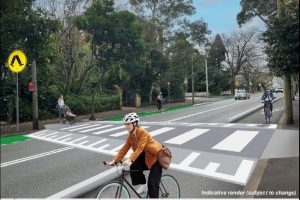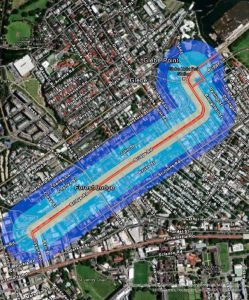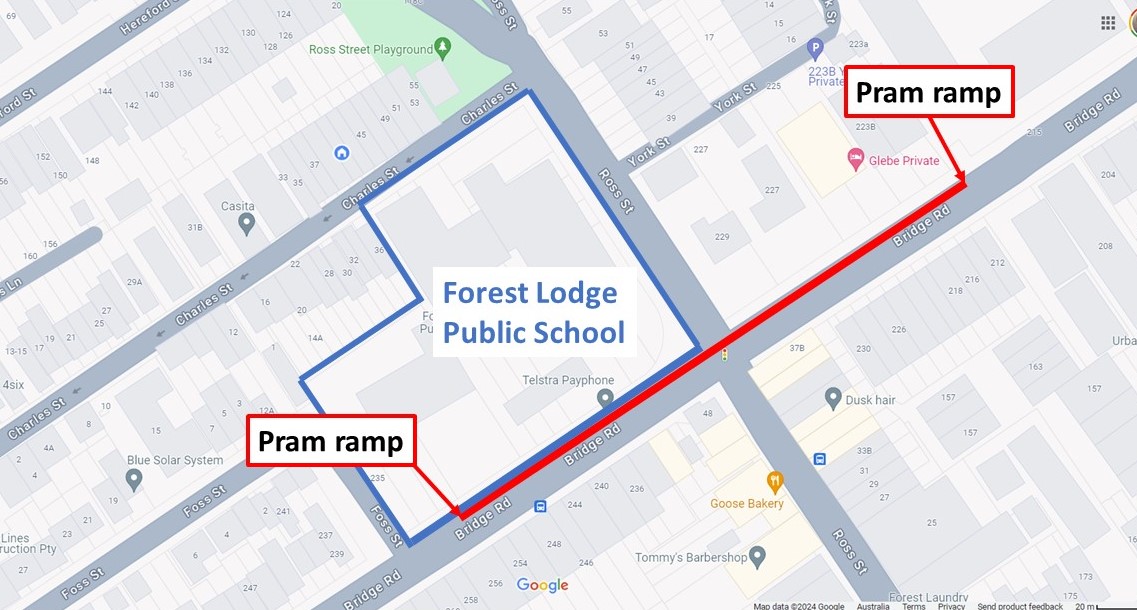by Di Anstey, Bridge Road resident and Founder of Bridge Road Friends, Bulletin 5/2024, July

If the contents of a recent cycleway update from Transport for NSW (TforNSW) are to be believed, residents of Bridge Road are in for eight months of sleepless nights to start soon. (See Figure 1). The proposed roadworks involve trenching and restoration of the existing underground Fish Markets electrical utility trench, asphalt-milling and re-sheeting to be undertaken before the long and oft promised installation of the permanent cycleway. On 14 October 2022, Tyson Kinnane from TforNSW advised in an email to me that installation of the permanent cycleway would start in the coming weeks.
On 16 May 2024, a Community Update with the cumbersome title Transport for NSW is closer to delivering the upgraded and permanent cycleway on Bridge Road, Glebe, linking the Inner West to Sydney’s Central Business District and beyond was emailed to those registered with TforNSW for updates on the cycleway.
There was no media release or letterbox drop to the wider Forest Lodge and Glebe community to alert them to the extreme disruption that lies ahead. The update stated:
- The tender process is now underway.
- We intend to complete it in the coming months and our contractor will then start work as soon as possible afterwards, later this year.
- We will continue to update the local community about our progress and ensure more information is communicated about the work well before it starts.
- Once appointed, our contractor will then provide regular updates.
This update from TforNSW raised more questions than it answered for angry residents still getting over months of sleepless nights and the acrid smell filling Bridge Road from the trenching works to increase electricity supply to the Fish Markets. The proposed work is to be conducted five nights per week in five stages which TforNSW estimate will take eight months (weather permitting).
Stage 1: Trenching and restoration of existing underground Fish Markets electrical utility trench.
Stage 2: Asphalt milling and re-sheeting, construction of raised pedestrian crossings at Cross Street and Woolley St. Demolition of existing median near Lyndhurst St and construction of new median.
Stage 3: The remainder of the cycleway upgrade would be constructed (including three of the pram ramps):
Stage 4: Sign-posting, line marking, installation of temporary Klemmfix barriers at Glebe Point Rd and Ross St extending the cycleway closer to intersections with appropriate line-marking for shortened right hand turn lanes, coloured surface coating for cycleway and lighting for the raised pedestrian crossing near Cross Street:
Stage 5: Evaluation of reduced right turn bays, removal of temporary Klemmfix barriers and adjustment of line-marking and concrete barrier to suit the adopted lengths of the right turn bays.
The email from TforNSW claimed that the cycleway will link to Sydney’s Central Business District. This however is patently untrue. The proposed permanent cycleway will finish at Taylor Street as does the current temporary infrastructure. There is no separated cycleway in front of the new Fish Markets for cyclists to ride into the CBD.

These recent comments on social media about the update suggest the community is sceptical and fed up with misinformation that has been provided about the construction of a permanent cycleway on Bridge Road.
Honestly you really think this mystical magical cycleway that has made a complete dog’s breakfast of the road for the small percentage of users who benefit from it is innovative and efficient?
They release the same ‘update’ every few months to distract from the fact that the cycleway hasn’t changed in four years
This is essentially the same release saying that they would start work in early 2024
The community should not be fooled by the ‘indicative render’ included in the Community Update as to how the cycleway will look. The design which has been released under Freedom of Information (GIPA) clearly shows embedded concrete slabs 400mm wide x 150mm high.
On 16 May 2024, an Expression of Interest Tender was published on the TforNSW eTendering website: Expression of Interest for Specific Contracts – An invitation for Expression of Interest (EOI) for pre-registration of prospective tenderers for a specific work or service. The tender was published on 16 May 2024 and closed on 13 June 2024. In response to a Question on Notice in NSW Parliament by Mark Banasiak of the Shooters & Fishers Party the Minister responded that the tender is ‘to test the market with an expanded scope’. A previous tender to construct the permanent cycleway was advertised on 23 March 2023 (three days before the NSW State election, while the previous government was in caretaker mode) and closed on 20 April 2023. No contract was awarded allegedly due to the scope of works being substantially altered.
On 25 January 2023, TforNSW issued a cycleway update to the community advising work to install the cycleway ‘is expected to commence in mid 2023’. The contents of an email from Julie Sundqvist, Director, Eastern Harbour City, Community and Place, TforNSW to City of Sydney on 15 February 2023 obtained under FOI (GIPA) strongly suggests the information in the TforNSW community update was not based on facts. In her email Ms Sundqvist stated, ‘We have no formal agreement in place and no budget to progress this work. So while ideally we would like to start in April, I don’t think we can commit to that until the proposal is formalised and funding is sorted.’
On 3 May 2023, TforNSW became aware that further trenching and remediation along the length of the electrical upgrade works on Bridge Road was required to meet TforNSW standards.
An Addendum Review of Environmental Factors (REF) was also published on TforNSW’s Bridge Road cycleway website on 16 May 2024 which covers the expanded scope of works. The original REF dated March 2022, which had never previously been published, was also uploaded to the website on the same day. Both the original REF and the Addendum REF, as well as other information, are available via this link to the cycleway project webpage: transport.nsw.gov.au/bridge-road-glebe-cycleway.
The proposed design for the cycleway has never been made public. An ‘Issue for Construction’ design dated June 2023 has been obtained under Freedom of Information. The proposed design for the permanent cycleway still raises serious safety concerns. Safety concerns include, but are not limited to:

The requirement for cyclists to merge into the general traffic lane at both Ross Street and Glebe Point Road intersections. In a letter to TforNSW released under Freedom of Information (GIPA), Chief Operating Officer of the City of Sydney says ‘if we don’t make cycleways safe then riders will not use them. Indications are that people don’t feel sufficiently safe with the current design. The TforNSW design of the permanent cycleway largely reflects the existing pop-up cycleway, where people are required to ride in mixed traffic for some 360 metres (on approach and departure of Ross Street and Glebe Point Rd intersections). We consider this to be an unacceptable road safety outcome’.
Shortening the right hand turn bays at the Ross Street and Glebe Point Road intersections with Bridge Road. Discussions had taken place between City of Sydney Council and TforNsw about banning right hand turns from Bridge Rd into Glebe Point Road (in both directions) and westbound on Ross Street. As a compromise TforNSW will implement a trial of shorter right turn bays at the Ross Street and Glebe Point Road intersections, enabling the cycleway to extend closer to intersections.
The shorter right turn bays would be implemented using temporary materials and will be evaluated to determine if there are any safety or traffic congestion issues.If the reduced right turn bays cause safety issues or unacceptable impacts to the road corridor, the temporary materials would be removed, and the length of the right turn bays would be adjusted to be consistent with the Addendum REF design. If the evaluation determines that the trial of reduced right turn bays is successful, the arrangement will be made permanent. The trial will only commence once the permanent cycleway has been constructed. There is no plan to shorten the bus right hand turn lane into Ross Street.
The design proposes installation of ‘pram ramps’ at various locations along the length of the cycleway. As stated in the Addendum REF:
The addition of pram ramps would allow people on bikes to enter the footpath at points where the cycleway merges with the traffic lane. This would allow people on bikes to avoid riding alongside vehicular traffic and provide a safer option for all road users.
Installation of ‘pram ramps’ will not entirely eliminate cyclists merging with general traffic lanes. Encouraging cyclists to use very narrow shared footpaths and in particular, the footpath outside Forest Lodge School, couldn’t be considered a safer option for all, especially considering the number of children using the footpath outside the school during morning peak hour.

Gordon Hughes Director of Cities and Active Transport Division, Transport for NSW is on the record expressing serious concerns regarding the safety of cycling on Bridge Road. In an email to colleagues released under GIPA dated 24 June 2021 Mr Hughes said,
There appears to be a defensive position set around Bridge Road. In general, the approach taken appears to be engineering-led focused based around acceptance of imbalance and compromise rather than practical planning that helps to better balance and set achievable targets. Based on the information presented I would suggest that we need to stop promoting Bridge Road as a cycleway for all users (especially the 48% less confident) as it doesn’t appear that these outcomes can be achieved.
Nicolas Kocoski, Senior Manager Network & Safety Services at TforNSW is on the record in an email to colleagues dated April 2021 that ‘St Johns Rd is a more attractive/safer route.’ Mr Kocoski wrote:
Howard, myself and James walked St Johns Road and saw a lot of merit in the cycleway to be installed along St Johns Road instead of Bridge Road, the two connections at either end back onto Bridge Road will need to be further investigated. City of Sydney preference is still Bridge Road. Pending the outcome of the REF/comms my view is that St Johns Road is a more attractive/safer route.
Questions arise as to why, in August 2023 the ‘independent’ design stage road safety audit was conducted on the design for the permanent cycleway by an auditor associated with the company who designed the cycleway. The report of the safety audit was provided under Freedom of Information.
Resident access issues were completely ignored in the REF undertaken on making the cycleway permanent in 2021 and the Addendum REF dated April 2024. That Bridge Road is an arterial road and carries in excess of 20,000 vehicles was ignored in both the REFs dated March 2022, and the Addendum dated April 2024. Section of 5.5 of the Environmental Planning and Assessment Act requires that Transport for NSW ‘examine and take into account, to the fullest extent possible, all matters affecting or likely to affect the environment by reason of the activity’. The environment surely includes amenity for residents. In this case ‘the activity’ is the cycleway. It is clear that construction of the cycleway and the resultant issues, were not examined to the fullest extent possible.
The April 2024 REF further states that the
operation of the features of the proposed modification would affect all users of Pyrmont Bridge Road and Bridge Road (including pedestrians, people on bikes, motorists, and public transport customers) and are expected to result in mostly positive changes to the existing environment. All features are designed to improve the safety and efficiency of travel for all users of the road and cycleway. Existing street parking would not be impacted.
Note that residents of Bridge Road are not included, and also that there is no street parking as it was removed in July 2020.
If the eight-month timetable for construction of the permanent cycleway indicated in the most recent update from TforNSW dated 16 May 2024 is correct, it will have been five years since the temporary cycleway was hastily installed in September 2020. At that time residents were assured via a community update from City of Sydney and Transport for NSW that the cycleway was temporary infrastructure to be in place for six months as part of the response to COVID-19. As work on the initial REF which, under Part 5 of EPA Assessment Act 1979 covered both the ongoing use of the temporary cycleway and the project to update it to a permanent cycleway, commenced in early January 2021, less than four months after the temporary cycleway was installed, and two months before the community consultation survey, the temporary nature of the cycleway was clearly a ruse and a permanent cycleway was always the plan.
From the editor
Further to what Di has written, I would like to highlight a couple of proposed changes that seem particularly egregious to me:
Note 1: The Addendum REF gives the standard noise mitigation measures appropriate to each noise zone (p. 45) and goes on to explain why, in almost all situations, those recommended mitigation measures will not be used during the construction of the Bridge Road cycleway.
Dark blue zone: the mitigation measure is ‘notification’ (N) – letterbox drops with certain information (p. 47).
Light blue zone: ‘notification (N)’, ‘respite period’ (R2) and ‘duration respite’ (DR): ‘Respite period’ would pace the construction so that residents would get breaks from the noise. While this is a mitigation measure recommended for residents experiencing the predicted level of night-time construction noise of 55 dB(A), “this is not recommended for this project as this measure would significantly extend the duration of works” (p. 96 of pdf). ‘Duration respite’ seems to allow increasing “the work duration (number of evenings or nights worked) for longer duration projects so that the project can be completed more quickly” (p. 96 of pdf) … which doesn’t sound like a noise mitigation measure at all.
Closest zone: As well as the recommended noise mitigation measures already mentioned, an additional recommended measure for residents in the closest zone is ‘phone calls’ (PC) “detailing relevant information made to identified/affected stakeholders within a minimum of 30 m radius”. This recommended mitigation is “considered impractical due to the large number of affected receivers [i.e. residents] within this radius”. Another recommended measure is ‘specific notification’ (SN) to ‘more highly affected receivers’ within 30 m of the proposal area than would be provided in letterbox drops (N). Again, this is ruled out as “it may not be reasonable to undertake separate types of notifications. Instead, a single coordinated message should be delivered to the affected community” (p.96 of pdf). Alternative accommodation (AA) is recommended for “‘highly intrusive’ noise levels such as those expected to affect the closest residents”, although it would be “in response to receiving a complaint and in accordance with Transport for NSW procedures”. It may come as no surprise to hear that this too is ruled out “due to the high number of noise receivers within the noise catchment area it would be impractical and difficult to consistently deliver alternative accommodation arrangements (p. 97 of pdf).
Note 2: Pram ramps giving cyclists footpath access may make cyclists safer, but surely the same cannot be said for pedestrians. At the Bridge Road/Ross Street intersection outside the school, pedestrians are often young children going to and from school and their parents, often with the baby or toddler in a pram and the family dog in tow.
The Addendum REF does not mention anywhere the risk to pedestrians of this arrangement. Instead, it boldly asserts the opposite: that the pram ramps (and raised crossings) will ‘enhance safety for pedestrians, especially children, elderly people, and people with disabilities, as well as people on bikes” (p. 53). It’s hard to imagine how the safety of children, elderly people, and people with disabilities could be ‘enhanced’ by sharing a narrow footpath with commuting cyclists and food deliverers.
And in case those entirely unsupported claims leave any reader unconvinced of the wonders of turning footpaths into cycleways – especially outside primary schools – they go full farce, breathlessly claiming that the added pram ramps and raised crossings may “improve social cohesion” and “foster an improved sense of community” (p. 53). To be fair, an attempt is made to justify the claim: pram ramps and raised crossings “encourage walking and cycling”, and (presumably) walking and cycling promotes social cohesion.









One comment. Please add yours.
I hope they start the cycleway already! I live in Glebe & use it daily to get to city & inner west, but it looks like building the entire new fish market building has been quicker than just making an existing cycleway permanent.
The new first markets look beautiful & I also can’t wait for them to launch. Especially as I’ll be able to take the cycleway straight to them!! (Whenever transport NSW actually start the cycleway works….it was originally meant to be completed in mid 2023, it’s now the end of 2024 & still waiting. This bureaucratic agency is soo slow..)